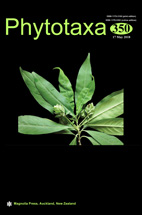Abstract
Several species in the genus Pleione (Orchidaceae) have same or overlapping geographical distribution in China. In this study, two new natural hybrids, Pleione × baoshanensis and Pleione × maoershanensis, were described and illustrated. The parentage for these two hybrids was confirmed using molecular data from ITS of the nuclear ribosomal, trnT-trnL spacer and trnL-trnF region (trnL intron and trnL-trnF spacer) of the plastid DNA. Pleione × baoshanensis is intermediate between P. albiflora and P. yunnanensis, and characterized by its erose lamellae on the lip. Meanwhile, Pleione × maoershanensis is intermediate between P. hookeriana (P. chunii) and P. pleionoides, and characterized by its deep lacerate lamellae on the lip. For the individuals tested, molecular data suggest that P. albiflora is the maternal parent of Pleione × baoshanensis, and P. hookeriana (P. chunii) is the maternal parent of Pleione × maoershanensis. The history and taxonomic status of P. chunii is also discussed.

